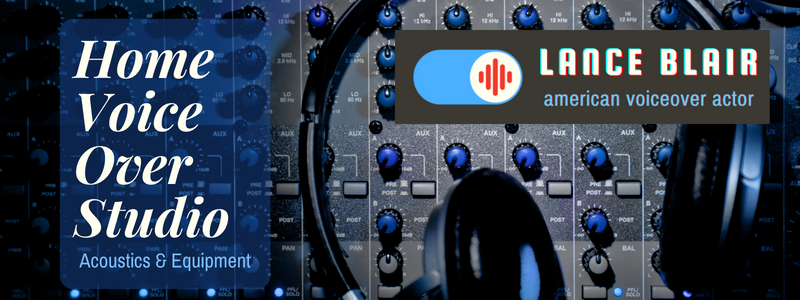Home Voice Over Studio Part One: The Set-Up
Let’s keep this simple: you want to set up a home voice over studio with a low noise floor. Also, how to do you re-create the quality audio sound you have at professional studios in your home environment? Studios have a high-end production signal chain from your voice, to the mic, to the equipment, to the software. Let’s try to to get as close as we can with no weak links in the chain. But the first step is the acoustics of the home studio. Without that, nothing else sounds good! I have written previously about what I use in my studio. Let’s get you up and running in your home voice over studio!
First Step: Choose your home recording area.
Find the quietest room in your house. A walk-in closet is good only if it’s truly large. Small closets sound boxy and boomy: the lower frequencies bounce around in a nasty way. Then, pick the corner of the room away from windows, doors, and any other noise. Close off that area as much as possible with dividers or tall furniture covered with thick blankets and pillows, and put blankets or other absorbing material on the walls of that section. Full bookshelves are a fantastic sound absorber and refractor. If you can record in a corner of a room with bookshelves, choose that. Have carpet on the floor, and put carpet or blanket on the desktop you’ll be using there. Hard desk surfaces bounce sound right back at the mic in what is called ‘early reflections’. If you can somewhat close off and acoustically treat a 4′ x 6′ to 6′ x 8′ area in your room you’ll be in great shape. Make sure you can access and turn off your home’s HVAC system temporarily when recording. For high quality affordable sound blankets that do the job properly, check out Vocal Booth to Go. And for acoustic panels and bass traps, consider the excellent GIK Acoustics.
Second Step: Choose Your Microphone
For a home voice over studio microphone, you need a Condenser (Not Dynamic) microphone that is either Supercardioid or Shotgun in regards to its microphone polar pattern. That way, the mic will be focused straight ahead on your voice, and not taking a wide shot of all the noise and sound reflections in your room. Think of it as normal lens vs. wide angle lens in a camera. You want the normal lens. For Shotgun microphones, quality choices range from the Audio Technica AT875R ($169) to the Rode NTG2 ($269), up to the industry standard Sennheiser MKH 416 ($1000). Non-shotgun condensers like the Shure Beta 27 and CAD E100S are more rare. But, there are good affordable choices like the Rode NT1 ($269) that are plain cardioid not supercardioid but sound more focused. For even less money I can highly recommend either the AKG P220 or AT 2035 (both around $135) which sound excellent, especially on female voices. None of these affordable choices have a very wide cardioid pattern.
Third Step: Pick your Audio Interface
So far, so good for your home voice over studio. Now you need an XLR cable to plug in your microphone to your Audio Interface. The Audio Interface will power your microphone with Phantom Power and will convert your analogue audio signal from the microphone into a digital signal which will then be recorded by your computer and recording software. I highly recommend Mogami Gold or Canare cables for your microphone, but whatever you can find that is decent quality will do the job. You will also need cables to plug in your speakers to the output of your audio interface. Usually 1/4″ jack cables are required.
Audio interfaces have come a long way in the past ten years. I still have the original Focusrite Scarlett 2i2 sitting in storage, and it’s significant step down when compared to the newest Third Generation version, which I would recommend. Anything by PreSonus, MOTU, Focusrite, SSL, or Steinberg under or around $200 will be all you need for quality recordings. For the past few years I’ve been using my SSL2 and it sounds great whether you use the internal preamps or external ones. Whatever you choose, just make sure it works well with your computer and computer inputs. Search for reviews on the particular audio interface that interests you.
Fourth Step: Speakers/Monitors and Headphones
Now it’s time for speakers/monitors and headphones. Mackie and PreSonus both make speakers that are good enough for checking mono voice over recordings for $100 a pair. If you want to spend more, Yamaha and KRK have good options. Headphones are crucial, especially for being able to set up your home voice over studio to make sure the sound is good. Here are the best options for $100 or slightly less:
Shure SHR440 : These are comfortable and very accurate.
Audio Technica ATH-M40x : They are very comfortable, but have a hyped bass response.
Sennheiser HD 280 PRO : These are not comfortable at first, and slightly heavier than the others; but they have extremely accurate sound.
Note that these are all closed-back headphones. This is very important. Opened-back headphones let the sound leak out, so the voice of your client will bleed into your microphone signal. You don’t want that!
Now you will have the acoustic environment and equipment you need to start making quality recordings in your home voice over studio. Look out for a new post where I will discus recording tips in your DAW recording software, with links to many valuable online tutorials for Audacity, Audition, and REAPER.
Good luck!

